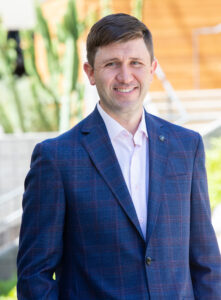Rare Community Profiles

Rare Community Profiles is a new Patient Worthy article series of long-form interviews featuring various stakeholders in the rare disease community, such as patients, their families, advocates, scientists, and more.
DTx Pharma is Developing Innovative RNA Therapeutics for CMT1A
In 2019, the DTx Pharma team attended a conference that would change the course of their business forever. When Dr. Arthur Suckow initially launched DTx Pharma, an RNA therapeutics company, he was excited to develop therapies that inhibited disease-causing genes, but he found himself faced with a challenge; many amenable genetic disorders, such as Duchenne muscular dystrophy (DMD), were already being explored by a host of companies, and he wanted to differentiate the company’s mission. So, when the DTx team met the Charcot-Marie-Tooth disease (CMT) Research Foundation, and later sat down for a meeting, they were thrilled at the opportunity before them. Dr. Suckow says:
“After reading a seminal paper describing Charcot-Marie-Tooth disease type 1A, or CMT1A, it hit me: this was exactly what we had been looking for. Two hours later, I was in talks with the CMT Research Foundation and by the end of the night, we were already making molecules for the target. I was in the hotel room just designing compounds. After an additional few months, the Foundation even funded experiments to determine whether the technology could work in this area.”
There were a multitude of reasons that CMT1A appealed to Dr. Suckow and the DTx team. First, the disease is progressively disabling and affects more than 150,000 people in the United States and Europe. In spite of the large unmet need, there are no approved therapies exist, presenting a huge opportunity to make a difference for patients. Additionally, the underlying genetics of the disease were clear and well-understood. With the NIH investing in a series of natural history studies over the past decade, providing important data to be leveraged in clinical development, the disease itself and the patient journey were becoming better understood.
Dr. Suckow recently shared with Patient Worthy more about DTx Pharma, what the company hopes to achieve in CMT1A, and why drug development in this realm can be both challenging and immensely rewarding.
About Dr. Arthur Suckow, PhD
Dr. Arthur Suckow, PhD received his Honors B.Sc. in Biological Sciences from the University of Delaware and his PhD in Biomedical Sciences, with a focus in Pharmacology, from the University of California, San Diego. His lab utilized neurobiology findings to attempt to treat pancreatic neuroendocrine tumors, also known as Islet cell tumors. Dr. Suckow later moved to the small molecule space while on the Diabetes Drug Discovery team at Johnson & Johnson and MedImmune before transiting towards biologics such as peptides, antibodies, and injectable conjugates. He shares:
“My research focused around the use of fatty acids on peptides to keep drugs in circulation for prolonged periods. For example, through using certain biologics, patients could receive a weekly or monthly injection rather than having to receive treatment multiple times per day.”

In 2016, Dr. Suckow joined the team at Regulus Therapeutics. It was there that he developed a keen understanding of the delivery challenges associated with RNA therapeutics. He explains:
“Your cells were trained over billions of years to reject RNA-like molecules, so drug development in this realm is tricky. Despite the potential to repress gene expression, it has proven difficult to get RNA therapies into cells. In many cases, RNA therapeutics are cleared quickly by the kidneys. So if you’re trying to deliver treatment to Schwann cells in peripheral nerves, the treatment is cleared before the cells ever see the drugs. Having worked on small molecules and fatty acids, I felt like there was a way to leverage those receptors to trick cells into taking up siRNA through a fatty acid, as well as leverage the fatty acids to extend half-life.”
His vision led him to co-found DTx Pharma. As CEO, Dr. Suckow now leads the charge in developing life-changing RNA therapeutics for rare or underserved peripheral nervous system, central nervous system (CNS), and muscular disorders.
A Brief Overview of DTx Pharma
DTx Pharma uses its versatile FALCON (Fatty Acid Ligand Conjugated Oligonucleotide) platform to develop therapeutics for conditions where the underlying genetics are well-understood. As Dr. Suckow shares:
“Other companies can deliver to the liver but just the liver, or the muscle but just the muscle. We’ve found that combinations of different fatty acids can get us to multiple areas of the body. Our therapy attaches fatty acids to siRNA, which is about 1/20 the size of what other companies are using for delivery. Those therapies use antibodies, which are around eleven times the size of the siRNA, which complicates manufacturing. We also hope that our FALCON approach will reduce treatment burden. Current technologies require patients to go for hours-long infusions every 4-6 weeks. We’re hoping to get our therapies to a point where patients can administer their treatment at home.”
DTx’s lead therapeutic candidate, DTx-1252, is being developed for Charcot-Marie-Tooth disease type 1A (CMT1A), which, although rare, is also the most commonly inherited neuromuscular disorder. Currently, no approved treatments exist for patients .
How Does DTx-1252 Address the Needs of Patients with CMT1A?
As explained on the DTx pipeline:
“CMT1A is driven by overexpression of the PMP22 gene in Schwann cells, which prevents myelination of peripheral nerves and causes symptoms including progressive muscle wasting, neuropathic pain, difficulty walking and, eventually for many, an inability to live independently, leading to a significant and debilitating impact on patient lives. By repressing PMP22, DTx-1252 reverses CMT1A in a mouse model that faithfully recapitulates the genetic and clinical manifestations of the disease. DTx-1252 treatment induces remyelination of axons to normal levels and increases muscle mass, grip strength, coordination and agility.
Prior to treatment, the CMT1A mice in the studies struggled with grip strength, coordination, and mobility. Expanding on the above, DTx-1252 showed significant improvements, even at early time points. Four weeks after receiving the treatment, the ability of the mice to walk across a beam (a very challenging task before treatment) was markedly improved; by12 weeks post-treatment, the mice could perform just about as well as the normal, non-CMT1A mice. The company has progressed to research in non-human primates and is very encouraged to see effects observed in rodents repeating well in the non-human primates.
Additionally, DTx Pharma is hoping to have an accepted Investigational New Drug (IND) application by the end of 2023, which would allow the company to move forward in clinical development. Dr. Suckow hopes to begin dosing patients in December 2023 or January 2024.
The Challenges of Rare Disease Drug Development
Of course, the drug development process is not always easy—especially within the rare disease space. One of the most challenging aspects, Dr. Suckow states, is setting reasonable expectations with both patients and investors. Drug development is a data-driven process which can take some time. Understanding how the therapeutic works, as well as its safety, efficacy and ideal dosing regimen in humans, are all critical elements to get right when bringing a drug to patients. Dr. Suckow explains that while the early benefit seen in the mouse studies is highly encouraging, we do not yet know if benefit in patients will be observed as quickly.
Another challenge with developing drugs for rare diseases is that there is not always a clear path to designing the clinical trial and finding patients most likely to benefit. Dr. Suckow explains:
“We’re also the first company to address the underlying genetic lesion that causes the disease, so we will be tasked with identifying patients who are most likely to respond, organizing natural history data, and aligning with agencies on the regulatory pathway and what they view as important endpoints.”
Despite these challenges, Dr. Suckow remains driven by his commitment to patients and improving their quality-of-life. From its founding, DTx has taken a patient-centric approach which has only been further reinforced through the relationship with the CMT Research Foundation. Moreover, the origin story of the CMT1A program highlights the power patients can have within the drug development field, when they challenge companies to consider new ideas, and the synergies that can exist between these patient communities and companies.
DTx maintains patient-centricity by working closely with the CMT Research Foundation. One father, a caregiver, often sends stories to Dr. Suckow; he posts them on a bulletin board at DTx so that the entire team can read them. The company stays connected in the field by frequently participating in conferences focused on CMT1A research. Monthly, DTx meets with advocacy groups to hear stories and better understand the patient journey for CMT1A. They present data and discuss how to best design clinical trials with the patient front of mind. Says Dr. Suckow:
“I rarely come away from those meetings without crying. Seeing their excitement and enthusiasm is what pushes me through. This past year, we also brought two patients to our company Christmas party to illustrate how important the work that we’re doing is. Even if we fall short of our goal, we hope that our work inspires continued interest in this industry and makes the lives of these patients better in the long-run.”


